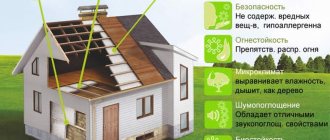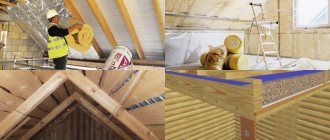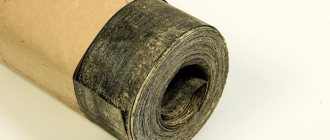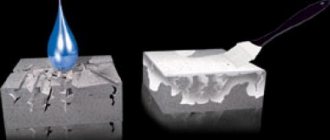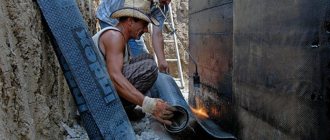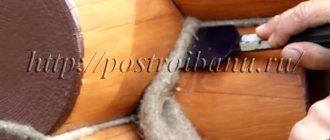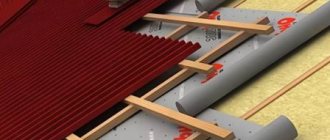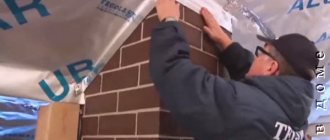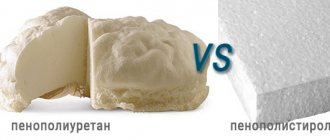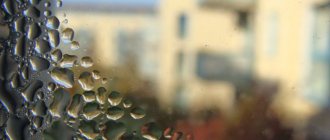Waterproofing the foundation of a house with rolled materials
Groundwater containing salts and acids, rain, melting snow are the worst destroyers of the foundation of any building.
Moisture on the surface of brick or concrete promotes the spread of microorganisms and the formation of fungus. Water penetrating into the structure of the stone, freezing, expanding and weakening the base, and when melting, washes the filler out of the concrete. This results in subsidence, distortions, and cracks, which can ultimately lead to the collapse of the house. Properly installed roll waterproofing for the foundation, also called adhesive waterproofing, allows you to avoid such consequences. Two types of insulation protection are used to protect a building from water penetration.
It is placed on the surface of the foundation under brickwork, wall panels or beams and runs along the entire perimeter of the building. Its main function is to cut off moisture from the walls. If there is no basement or the presence of dampness is insignificant, then it is enough to do only horizontal waterproofing of the foundation.
This type is used when there is a high base or a basement, when the foundation is also the walls. In this case, the main task is to separate concrete from groundwater and precipitation.
The outer (street) side of the concrete base, not only its above-ground part, but also its underground part, must be protected from moisture. Therefore, waterproofing the foundation with rolled materials is done even before backfilling the pit and to the full height. If the basement is underground, then both types of protection must be used. Vertical waterproofing is done along the walls, and horizontal waterproofing is done at the floor level in the basement and along the surface of the plinth (120 mm above the blind area).
Material requirements
To isolate a concrete base, various types of roll waterproofing are used, but they all must meet certain requirements and have the following properties:
- tensile strength;
- elasticity;
- flexibility;
- low water absorption (except glassine);
- resistance to chemical influences;
- punching resistance;
- elongation at break;
- durability.
Rolled waterproofing materials are by far the most convenient type of protection against water. To work with them, special skills or a team of workers are not required; everything can be done with your own hands.
The most popular for this type of work is a waterproofing material based on fiberglass impregnated with bitumen-polymer mastic. One of the first places is occupied by the TechnoNIKOL trademark, which produces roofing felt, technoelast, hydroisol and stekloizol. The products it produces fully meet all requirements, are simple and easy to use, and are of good quality.
The structure of roll waterproofing is multilayer: a fiberglass or polymer base is located between two layers of bitumen mastic. The outer one is additionally protected with mineral chips, and the inner one is covered with a special film to prevent the strips from sticking together in the roll. Insulation is produced in rolls 1 wide and 10–12 meters long. It is so popular and in demand that you can buy Technonikol in any hardware store at an affordable price.
Base, reinforcement
To equip the foundation with waterproofing, you do not need to use glass-based building materials. It does not have certain characteristics in terms of resistance to chemical influences, which, in turn, reduces the service life of the foundation.
To ensure that the foundation insulation lasts a long time, it is better to use polyester-based roll material. Due to its elasticity, this building material is often used in structures of various types, including those in which large possible deformation of the waterproofing coating is calculated. Waterproofing, which involves building materials based on oxidized bitumen, is such that the polyester base refuses to work properly. Because the deformability of this base is significantly higher than the elasticity of oxidized bitumen at zero temperatures. In addition, building materials of this base are characterized by increased resistance to chemicals and a longer service life.
Base, reinforcement
Installation method step by step
The tools needed for the job are simple and do not require any special skills. To waterproof the foundation with adhesive materials you will need:
- gas-burner; it is needed for heating and welding the joints between strips of material;
- a wooden trowel or heavy roller for smoothing the surface of the insulation for the purpose of more dense gluing and expelling air bubbles from under the roll.
The base for the roll insulation needs to be cleaned of dirt and dust, bulges knocked down and recesses covered. The seams between blocks or panels must be caulked with mortar, and expansion joints must be filled with special elastic mastic to avoid the occurrence of ruptures in the coating in these places during shrinkage of the house.
If partial repairs do not level the base, then you need to make a cement screed (plaster) over its entire surface with a thickness of 10–30 mm. After the solution has dried, it is recommended to prime the entire surface with a primer (liquid bitumen mastic) to remove dust and better adhesion of the rolled material to the concrete.
Construction of a horizontal protective layer
The next stage of foundation waterproofing is gluing the fabric onto the prepared surface. To isolate the ground part of the concrete base with minimal dampness, you can use glassine or roofing felt. These materials are not as durable, but if they are subsequently protected from weathering, they will last a long time.
For underground parts or parts exposed to strong moisture, it is necessary to use TechnoNIKOL type waterproofing (for example, Stekloizol). Strips 100 mm wider than the foundation are cut from the roll and glued to bitumen mastic with an overlap of 100–150 mm at the joints along the entire perimeter of the house.
Vertical waterproofing device
This work is quite labor-intensive and cannot be done alone, but this method is the most reliable.
1. The roll is rolled out for “curing”, this will reduce the number of waves and air bubbles under the strip.
2. When using TechnoNIKOL foundation waterproofing, the rolls can be rolled out from top to bottom with overlapping strips of 150 mm, or they can be glued along the wall, starting from the bottom. Here the overlap of the upper strip onto the lower strip is made at least 100 mm.
3. The mastic should be applied immediately before gluing the roll of waterproofing material and in small areas (so that it does not have time to dry). Immediately iron the glued part with a roller or smoother to press it more tightly and expel the remaining air.
4. Upon completion of work, the joints between the strips of adhesive waterproofing must be thoroughly heated with a gas burner until the strips are completely welded. Particular attention should be paid to the quality of the seam when laying out the TechnoNIKOL roll vertically. Water flowing down will easily find any flaw in the weld and penetrate under the blade.
5. The next layer (the number can be any, but not less than two) is glued after the previous one has completely dried with a seam shift of at least 250 mm.
- Waterproofing must be applied continuously and evenly over the entire surface and at the joints of structures.
- You cannot use materials that destroy each other at the same time (for example, bitumen mastic and PVC film).
- In the lower part of the foundation, a transitional fillet (shoulder) is made at an angle of 45° to the wall, TechnoNIKOL is glued onto it in two layers, and the top one should be 100–150 mm longer than the bottom one.
- After installing waterproofing protection, the foundation of an already built house can be strengthened with polymer membranes.
Comparative prices for roll materials of the TechnoNIKOL brand
Roll material application technology
Since waterproofing materials are offered in the form of solid rolls, they must be cut before work. They are used to make strips of such dimensions as to ensure an overlap at the bottom onto the strip bent from under the sole, not forgetting about launching onto a horizontal surface of 20–30 cm, taking into account the height of the foundation.
In the process of waterproofing, be sure to comply with the requirements defined by SP 45.13330, SNiP 3.04.01, as well as MDS manuals 12–34.
During work, the following steps must be completed:
- sealing seams and cracks using fiberglass, this is a special fiberglass-based mesh impregnated with rubber and bitumen mastic;
- The corners of the concrete surfaces must be treated in at least two layers with a pre-selected waterproofing material.
Laying features
Since each waterproofing material has its own purpose, this determines the peculiarities of its installation technology:
- An adhesive composition is used to fasten materials without bitumen coating.
- When working with glass roofing felt, foil-isolon, or insulation, a layer of bitumen mastic is first applied to the concrete bases of the foundation and only after that the prepared waterproofing material is laid.
- To protect structures using bitumen-coated materials, they are first heated with a torch and then rolled onto the concrete.
- When using waterproofing with a self-adhesive layer, it is first leveled and then passed over it with a roller.
To protect the structure on the vertical edges, the material must be glued from bottom to top, not forgetting about the overlap on the adjacent strip of 10 cm. The longitudinal seams may be displaced in different layers, but not more than 30 cm.
When gluing waterproofing to horizontal areas, the overlap should be 20–30 cm, and the material itself should be laid parallel to the walls.
Where is it used?
Roll materials can be used in the following cases:
- vertical protection of the supporting part of the house from the inside and outside;
- insulation of prefabricated strip foundation at the basement floor level;
- foundation edge insulation for all types (strip, slab, pile, column);
- laying the blind area into the structure;
- waterproofing foundation slabs.
Rolled materials are quite popular as insulating materials
It is mandatory for all types of foundations to provide a waterproofing layer at the point of contact between materials with different physical properties (foundations and walls). This is due to the fact that the normal humidity for each structure is different, which can lead to damage to any of them.
To prevent unpleasant consequences, it is necessary to provide protection against such a phenomenon at the design stage.
Types of roll insulation
The following types of materials are produced in rolls:
The most modern are diffusion membranes . It is most difficult to work with adhesive types of materials, since before fixing them you need to apply a bitumen-based adhesive to the surface.
Pasting materials
The adhesive waterproofing of the foundation is carried out using the following materials:
- glassine;
- roofing felt;
- glass insulation
Scheme of adhesive waterproofing
The most unreliable option among those considered is glassine. It is manufactured in accordance with GOST 2697-83 and consists of sheets of roofing cardboard impregnated with petroleum bitumen. The method replaced insulation with materials such as sheeting and roofing felt. At the moment, glassine is not used often, and if it is used, it is for structures with a low degree of responsibility. The advantages include low cost. The disadvantages are short service life and low reliability.
Ruberoid is similar to glassine. This roll insulation is also based on roofing cardboard.
Impregnation is carried out with petroleum bitumen. Roofing felt differs from the previous version in the presence of a protective coating. It is made from refractory bitumen, with a coating of asbestos or talc on top, which protects the material from mechanical stress. The advantages of the material include:
- low cost;
- longer service life compared to glassine.
Disadvantages: instability to fire and rupture. Ruberoid is suitable for protection against moisture when groundwater is deep.
Covering the foundation with glass insulation becomes the most effective. Ruberoid and glassine, made on the basis of cardboard, are inferior to this material in terms of strength. Fiberglass fabric (fiberglass) is used as the basis for glass insulation, which allows the insulation to acquire high tear resistance. In addition, fire resistance properties are improved.
Welded materials
Welded foundation waterproofing allows you to reduce the complexity of the process. There is no need to use adhesives or bitumen compounds. The roll has a bottom layer of binder, which melts when heated and allows the layer to be securely fixed to the surface. Welded materials have several common features:
- production on a synthetic basis;
- reinforced with polyester fiber, which gives increased tensile strength and resistance to mechanical damage;
- durability due to resistance to rotting and external factors.
Scheme of built-up waterproofing
The most famous manufacturer that deals with weld-surfaced roll materials is TechnoNIKOL. This company produces such waterproofing as:
These types have proven themselves when used as vertical and horizontal insulation.
Diffusion membranes
This is the most modern method of insulation. Different membranes are available for use with horizontal and vertical protection. You can distinguish them by their appearance:
- for horizontal insulation – smooth film;
- for vertical insulation – profiled membrane.
Structure of diffusion membrane for waterproofing
Can also be used for making blind areas. In this case, the structure does not come to the surface, but becomes an invisible defender of the foundation. Not suitable if you plan to use the blind area as a walking path around the house.
Work technology
Protection with roll products varies depending on the application. Each case must be considered separately.
Vertical insulation
Required for house strip supports. Roofing felt on bitumen mastic, stekloizol, linokrom, waterproofing or membranes are suitable for the work. The work can be done both from inside the basement walls and from the outside. Rolled insulation is difficult to cope with the pressure of ground moisture, so it is used at low water levels. The work is performed in the following order:
Scheme of vertical and horizontal waterproofing of the foundation
- cleaning the surface from dust, dirt, grease, traces of old insulation or finishing;
- leveling the base; if there are large enough cracks or potholes, they are sealed with cement mortar;
- surface priming;
- cutting sheets, which takes into account the overlap of the material (10-15 cm);
- strengthening the corners of the foundation (installing fillets, securing reinforcing tape);
- installation of insulation depends on the chosen material (for adhesive, first apply a layer of mastic, and then apply roofing felt or glass insulation; to secure the welded insulation, its lower surface is heated with a torch or a hair dryer and attached to the foundation tape);
- roofing felt, stekloizol, linokrom and waterproofing are mounted in several layers to ensure greater reliability;
- The last step is to apply the finishing layer of mastic or varnish.
Horizontal insulation
Suitable for all types of bases when cutting foundations. Also needed for slab foundations. At the junction of the wall and the plinth, it is most often enough to lay two layers of welded or adhesive material (roofing felt, linochrome, waterproofing).
It is worth understanding the insulation of the slab in more detail. Here it is possible to use all the options discussed above, depending on the financial capabilities of the future owner of the house.
The work technology is as follows:
- compaction of the foundation soil;
- backfill made from materials not subject to heaving (crushed stone, gravel, coarse-grained or medium-grained sand);
- production of concrete preparation from “lean” mortar (serves as insulation and leveling layer);
- time for concrete to gain strength;
- cleaning the surface from dirt, dust, grease;
- leveling and priming;
- laying waterproofing material (carried out in accordance with the chosen option, it is important to follow the manufacturer’s recommendations);
- installation of thermal insulation and vapor barrier;
- pouring the slab.
Proper use of rolled materials will reliably protect the main supporting structure of the house.
Surface preparation
Surface preparation is one of the most critical stages of waterproofing installation.
If you make serious mistakes at this stage, then even using high-quality material will not save the situation. After the first months of operation, the waterproofing layer will begin to separate from the main surface.
To ensure the required level of surface preparation, four methods are used:
- Mechanical.
To level the surface, hammer drills, sandblasters, and jackhammers are used. Hand tools may also be used.
- Hydraulic.
To use this method, you will need to purchase or rent a water jetting unit that sprays liquid under a pressure of at least 180 atmospheres.
- Thermal.
Surface preparation is carried out using propane or acetylene torches.
- Chemical.
Hydrochloric or phosphoric acid is used to prepare the surface.
When the preparatory work is completed, before installing the waterproofing material, it is necessary to carry out a series of studies and checks to ensure that the surface meets the following requirements:
- Lack of easily separable elements.
- No cracks, chips or shells.
- The deviation in surface evenness should not exceed 5 mm per 2 meters.
- No dust or other contaminants.
- Surface humidity – no more than 4%.
After leveling and cleaning the surfaces, priming begins. This operation is performed to ensure increased adhesion of the waterproofing material. To increase the “tenacity” of the base, a bitumen primer is used.
If the moisture content of the foundation concrete cannot be normalized, then TechnoNIKOL primer, developed specifically for such cases, should be used. This product can be used with a percentage of water in solid material of up to 8 units. In order to find out the moisture content of concrete, it is necessary to use a special device - a vlogometer.
The primer should be applied using a brush, even for large volumes of work. Tools of various widths can be used for this purpose. Only small brushes with soft bristles should be used for interior corners.
After the surface has been coated with primer and the composition has completely hardened, you can begin the direct installation of the roll waterproofing.
Why do you need foundation waterproofing?
It is necessary to protect the foundation from the negative influence of the aquatic environment for several reasons:
- Firstly, in the upper layers of the soil quite often there is an accumulation of moisture, which can penetrate into the foundation by capillary action or exert a certain pressure on the base. In both cases, an unprotected foundation is at serious risk.
- Secondly, water is present in a certain amount in any layer of soil. In this case, the foundation is not subject to dynamic influence, but moisture penetration in this case cannot be avoided. When water gets into the foundation and freezes, it has a destructive effect.
- Thirdly, groundwater on the site can be located close to the surface, having a negative impact not only on the foundation of the house, but also on the entire structure.
- Fourthly, water entering the soil may contain aggressive chemical compounds. This inevitably leads to destruction of the concrete base.
Types of roll waterproofing
The modern construction industry produces several types of rolled materials used for waterproofing foundations:
Types of roll waterproofing
- Pasted roll waterproofing is a waterproof material that has different compositions and is rolled into rolls. When installing this type of protection, the material is glued to the surface using bitumen mastic. Among materials of this type, roofing felt and glass insulation are especially popular.
- Fused waterproofing involves the use of a construction hair dryer or burner. These tools are necessary to soften the bitumen layer. This ensures good adhesion of the waterproofing material and the protected surface.
- A diffusion film membrane is a modern high-tech material that not only protects the foundation from moisture penetration, but also removes excess moisture from inside the room. This allows you to maintain the integrity of the foundation over time.
Methods for laying rolled waterproofing depending on its type
Each type of roll waterproofing has its own method of construction or installation. Next, we will study each method separately.
Installation of built-up waterproofing
Fused waterproofing is laid on the surface by fusing the active layer using live fire.
Laying technology:
- Surface preparation – Removing dirt and dust;
- Primer – Application of a bitumen primer to improve the adhesion of the roll to the base;
- Preparation of tools – Filling gas burners with gas;
- Fusing the 1st layer – Using gas burners and fire, the first layer of rolled insulation is fused. The rolls are fused to overlap each other by 15 cm;
- Fixation – In parallel with fusing, the rolls are pressed to the base with a special roller;
- Fusing the 2nd layer – Similarly to the first layer, the 2nd layer is fused, so as to overlap the seams of the first layer.
By clicking on the link, you can download detailed instructions for installing weld-on materials from our partners TechnoNIKOL - Instructions for installing a waterproofing membrane made of bitumen-polymer roll materials.
Video instructions for laying rolled weld-on waterproofing:
Installation of pre-mounted waterproofing
Mounted types of waterproofing coatings do not have adhesion or adhesion to the base and are attached to the edges using strips and self-tapping screws.
Installation technology:
- Preparing the base and cleaning it from dirt;
- Installation of geotextile fabric with fixation to the base;
- Fastening of rolls at the edges with special clamping strips and clamps;
- Installation of PVC or TPO rolls with an overlap of 15 cm;
- Sewing rolls using a hair dryer or a special installation that heats the joint to a temperature of 550-650 degrees. When making vertical connections or lifts on various structures, it is preferable to use a construction hair dryer.
By clicking on the link, you can download detailed instructions for installing rolled PVC membranes from our partners SIKA - Instructions for laying rolled PVC membrane waterproofing from Sika.
By clicking on the link, you can download detailed instructions for installing rolled TPO membranes from our partners SIKA - Instructions for installing rolled waterproofing from TPO membranes from Sika.
By clicking on the link, you can download detailed instructions for installing rolled PVC materials from our partners TechnoNIKOL - Installation instructions for a waterproofing system made of PVC membranes.
Video instructions for installing PVC membrane:
Installation of adhesive waterproofing
The adhesive waterproofing is installed by gluing it to the base. We are mainly talking about self-adhesive rolls.
Laying technology:
- Cleaning the base;
- Cutting sheets to the required size according to the height of the base;
- Construction and application of bitumen primer;
- Gluing rolls onto the base by rolling them from bottom to top. Rolls are glued with an overlap of 15cm;
- Pressing rolls to the base;
- When installing additional layers, the surface is again coated with bitumen primer, and then another layer of waterproofing is glued onto it in order to cover the seams of the previous one.
By clicking on the link, you can download detailed instructions for installing adhesive membranes from our partners TechnoNIKOL - Installation instructions for adhesive insulation.
Video instructions for installing adhesive materials:
Methods for installing roll waterproofing
Installation of the waterproofing layer can be carried out in several ways. This depends on the type of protection chosen.
Welded and adhesive waterproofing
Welded and adhesive waterproofing
Work to protect the foundation from moisture using pasted or fused rolled materials must be carried out in the following order:
- The surface is treated with a special primer, which will serve as additional protection and also act as a heat insulator.
- Apply mastic or varnish in one layer. This allows you to increase adhesion between waterproofing materials and the protected surface.
- Lay waterproofing. In this case, it is best to lay lining roll materials in two or three layers, coating the joints of the strips with mastic. The welded waterproofing is laid in one layer, heating the material with a gas burner.
- An additional layer of mastic or varnish must be applied on top of the waterproofing.
- Protects the waterproofing coating. To do this, you can lay thermal insulation or brick.
- At the end of the work, the foundation is backfilled or a blind area is built.
Membrane waterproofing
The membrane is a relatively new material with a specific installation technology. However, there is nothing difficult in performing this process, the main thing is to follow certain rules:
- Waterproofing of the vertical surfaces of the foundation is carried out using a profiled membrane, which has protrusions in the form of spikes on one side. This structure evenly distributes pressure on the base of the house. In addition, the outer studded side contributes to the condensation of moisture and its release into the drainage.
- To fasten the profiled membrane, special metal elements coated with PVC are used. The fasteners are mounted on the surface of the foundation, and the waterproofing is fastened using a special construction heat gun.
- For waterproofing horizontal planes, it is recommended to use a smooth membrane. It prevents moisture from rising through the pores of concrete. The smooth membrane is laid on the foundation with an overlap. A construction hair dryer is also used to weld joints.
Vertical waterproofing
The process of vertical waterproofing is not complicated, but labor-intensive. Therefore, you will need an assistant for the job. All actions are performed in the following order:
- The rolled material must be rolled out to straighten it. This will reduce the formation of air bubbles during installation.
- Waterproofing can be glued vertically from bottom to top, maintaining an overlap of strips of 15 cm. It is allowed to stick the material along the foundation walls. In this case, installation also begins from below, but the overlap in this case can be reduced to 10 cm. The same principles are observed when using built-up waterproofing.
- The glued strip of waterproofing material must be ironed using a roller or a special iron. This will allow the material to be pressed more tightly to the surface and the remaining air to be expelled. After all vertical planes of the foundation are protected, the joints of the strips are heated well with a gas burner to completely bond the waterproofing strips.
- To apply the next layer, you must wait until the previous one has dried. In this case, it is important to move the seams at a distance of at least 25 cm.
Horizontal waterproofing
Horizontal waterproofing of the foundation
To waterproof horizontal surfaces, perform the following steps:
- The working surface is covered with a layer of sand and leveled.
- Geotextiles are laid on top of the sand layer, stacking the sheets on top of each other by 15 cm.
- Then the waterproofing is laid, maintaining an overlap of up to 10 cm between the sheets. The waterproofing material is welded using a construction hair dryer.
- An additional layer of geotextile is placed on top of the membrane.
- The final stage will be laying polyethylene and installing a concrete screed.
Waterproofing a monolithic foundation
- The surface is carefully leveled using a cement-sand screed.
- After the screed has dried, a layer of bitumen mastic is applied.
- A layer of waterproofing is laid on top of it.
Video description
This video presents a master class from Technonikol on the installation of self-adhesive roll waterproofing of the foundation:
Membrane fabric
Innovative roll waterproofing differs not only in design, but also in installation technology. The profiled sheet is attached to the foundation using special dowels with a PVC clamping cap. Sealing of joints is carried out using a construction heat gun. That is, the adhesion of the edges is carried out using a welding technique.
Membrane foundation waterproofing Source aquamasterplumbing.com
Expert advice
You can waterproof the foundation with your own hands; to do this, you must follow the work technology. In addition, there are some nuances that help improve the quality of waterproofing:
- Waterproofing must be continuous and uniform both on the surface and at the joints of structural elements.
- It is not recommended to use materials that can destroy each other when interacting.
- After installing the waterproofing, you can provide additional protection with a polymer membrane.
High-quality waterproofing of the foundation using rolled materials will ensure its reliable and long-term operation, making the entire constructed structure durable and safe.
